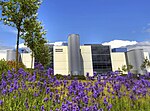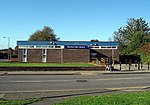Framwellgate Moor
Areas of Durham, EnglandCivil parishes in County DurhamCounty Durham geography stubs

Framwellgate Moor is a village and civil parish in County Durham, England. It is situated to the north of Durham, and is adjacent to Pity Me and Newton Hall. It had a population of 5,404 in the 2011 Census. With a slight increase to 6,112 in a 2018 local report.It is the location of New College Durham, the major further education establishment of the city. In addition, it is the location of Framwellgate School Durham which is a large and successful comprehensive school, science college and sixth form centre. The civil parish is based on the village of Framwellgate Moor and also includes neighbouring Pity Me and Brasside.
Excerpt from the Wikipedia article Framwellgate Moor (License: CC BY-SA 3.0, Authors, Images).Framwellgate Moor
Whitfield Court,
Geographical coordinates (GPS) Address Nearby Places Show on map
Geographical coordinates (GPS)
| Latitude | Longitude |
|---|---|
| N 54.799 ° | E -1.59 ° |
Address
Whitfield Court
Whitfield Court
DH1 5BT
England, United Kingdom
Open on Google Maps





